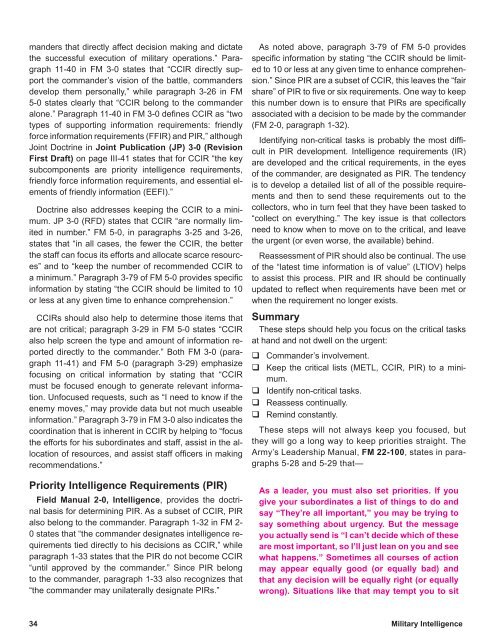Military Intelligence Professional Bulletin - Federation of American ...
Military Intelligence Professional Bulletin - Federation of American ...
Military Intelligence Professional Bulletin - Federation of American ...
You also want an ePaper? Increase the reach of your titles
YUMPU automatically turns print PDFs into web optimized ePapers that Google loves.
manders that directly affect decision making and dictate<br />
the successful execution <strong>of</strong> military operations.” Paragraph<br />
11-40 in FM 3-0 states that “CCIR directly support<br />
the commander’s vision <strong>of</strong> the battle, commanders<br />
develop them personally,” while paragraph 3-26 in FM<br />
5-0 states clearly that “CCIR belong to the commander<br />
alone.” Paragraph 11-40 in FM 3-0 defines CCIR as “two<br />
types <strong>of</strong> supporting information requirements: friendly<br />
force information requirements (FFIR) and PIR,” although<br />
Joint Doctrine in Joint Publication (JP) 3-0 (Revision<br />
First Draft) on page III-41 states that for CCIR “the key<br />
subcomponents are priority intelligence requirements,<br />
friendly force information requirements, and essential elements<br />
<strong>of</strong> friendly information (EEFI).”<br />
Doctrine also addresses keeping the CCIR to a minimum.<br />
JP 3-0 (RFD) states that CCIR “are normally limited<br />
in number.” FM 5-0, in paragraphs 3-25 and 3-26,<br />
states that “in all cases, the fewer the CCIR, the better<br />
the staff can focus its efforts and allocate scarce resources”<br />
and to “keep the number <strong>of</strong> recommended CCIR to<br />
a minimum.” Paragraph 3-79 <strong>of</strong> FM 5-0 provides specific<br />
information by stating “the CCIR should be limited to 10<br />
or less at any given time to enhance comprehension.”<br />
CCIRs should also help to determine those items that<br />
are not critical; paragraph 3-29 in FM 5-0 states “CCIR<br />
also help screen the type and amount <strong>of</strong> information reported<br />
directly to the commander.” Both FM 3-0 (paragraph<br />
11-41) and FM 5-0 (paragraph 3-29) emphasize<br />
focusing on critical information by stating that “CCIR<br />
must be focused enough to generate relevant information.<br />
Unfocused requests, such as “I need to know if the<br />
enemy moves,” may provide data but not much useable<br />
information.” Paragraph 3-79 in FM 3-0 also indicates the<br />
coordination that is inherent in CCIR by helping to “focus<br />
the efforts for his subordinates and staff, assist in the allocation<br />
<strong>of</strong> resources, and assist staff <strong>of</strong>ficers in making<br />
recommendations.”<br />
Priority <strong>Intelligence</strong> Requirements (PIR)<br />
Field Manual 2-0, <strong>Intelligence</strong>, provides the doctrinal<br />
basis for determining PIR. As a subset <strong>of</strong> CCIR, PIR<br />
also belong to the commander. Paragraph 1-32 in FM 2-<br />
0 states that “the commander designates intelligence requirements<br />
tied directly to his decisions as CCIR,” while<br />
paragraph 1-33 states that the PIR do not become CCIR<br />
“until approved by the commander.” Since PIR belong<br />
to the commander, paragraph 1-33 also recognizes that<br />
“the commander may unilaterally designate PIRs.”<br />
34<br />
As noted above, paragraph 3-79 <strong>of</strong> FM 5-0 provides<br />
specific information by stating “the CCIR should be limited<br />
to 10 or less at any given time to enhance comprehension.”<br />
Since PIR are a subset <strong>of</strong> CCIR, this leaves the “fair<br />
share” <strong>of</strong> PIR to five or six requirements. One way to keep<br />
this number down is to ensure that PIRs are specifically<br />
associated with a decision to be made by the commander<br />
(FM 2-0, paragraph 1-32).<br />
Identifying non-critical tasks is probably the most difficult<br />
in PIR development. <strong>Intelligence</strong> requirements (IR)<br />
are developed and the critical requirements, in the eyes<br />
<strong>of</strong> the commander, are designated as PIR. The tendency<br />
is to develop a detailed list <strong>of</strong> all <strong>of</strong> the possible requirements<br />
and then to send these requirements out to the<br />
collectors, who in turn feel that they have been tasked to<br />
“collect on everything.” The key issue is that collectors<br />
need to know when to move on to the critical, and leave<br />
the urgent (or even worse, the available) behind.<br />
Reassessment <strong>of</strong> PIR should also be continual. The use<br />
<strong>of</strong> the “latest time information is <strong>of</strong> value” (LTIOV) helps<br />
to assist this process. PIR and IR should be continually<br />
updated to reflect when requirements have been met or<br />
when the requirement no longer exists.<br />
Summary<br />
These steps should help you focus on the critical tasks<br />
at hand and not dwell on the urgent:<br />
�<br />
�<br />
�<br />
�<br />
�<br />
Commander’s involvement.<br />
Keep the critical lists (METL, CCIR, PIR) to a minimum.<br />
Identify non-critical tasks.<br />
Reassess continually.<br />
Remind constantly.<br />
These steps will not always keep you focused, but<br />
they will go a long way to keep priorities straight. The<br />
Army’s Leadership Manual, FM 22-100, states in paragraphs<br />
5-28 and 5-29 that—<br />
As a leader, you must also set priorities. If you<br />
give your subordinates a list <strong>of</strong> things to do and<br />
say “They’re all important,” you may be trying to<br />
say something about urgency. But the message<br />
you actually send is “I can’t decide which <strong>of</strong> these<br />
are most important, so I’ll just lean on you and see<br />
what happens.” Sometimes all courses <strong>of</strong> action<br />
may appear equally good (or equally bad) and<br />
that any decision will be equally right (or equally<br />
wrong). Situations like that may tempt you to sit<br />
<strong>Military</strong> <strong>Intelligence</strong>
















